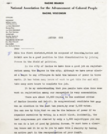
A letter about the importance of voter registation of African American voters in the upcoming election from 1957.
- Subject:
- Civics and Government
- Social Studies
- Material Type:
- Primary Source
- Author:
- Nicholas Schueller
- Date Added:
- 06/20/2022

A letter about the importance of voter registation of African American voters in the upcoming election from 1957.
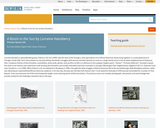
This collection uses primary sources to explore Lorraine Hansberry's play, A Raisin in the Sun. Digital Public Library of America Primary Source Sets are designed to help students develop their critical thinking skills and draw diverse material from libraries, archives, and museums across the United States. Each set includes an overview, ten to fifteen primary sources, links to related resources, and a teaching guide. These sets were created and reviewed by the teachers on the DPLA's Education Advisory Committee.
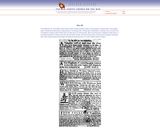
The September 18, 1762 edition of the South Carolina Gazette included notices of stray animals, runaway wives, and escaped slaves. Along with breaking tools, feigning illness, and slowing work, running away, individually or in groups, was a common form of resistance to slavery. Most of those who ran away did so for short periods, often to visit spouses or relatives on other farms, or to escape punishment. Chances were slim for permanent escape, and most of those who ran away were eventually reenslaved. Still, some escaped slaves found refuge with Native American groups or in small, isolated maroon colonies.
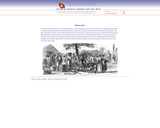
A master distributed provisions in an illustration from a weekly newspaper report on the operations of a plantation around 1860. The engraving suggested that this planter provided his slaves with a varied and nutritious diet, which was not usually the case. Slaves typically received a weekly ration of only three and a half pounds of salt pork or bacon and a quarter bushel of cornmeal. Although high in calories needed to perform heavy labor, that diet was seriously deficient nutritionally. This engraving did not show that slaves who wished to supplement their meager and boring diet had to rely on the vegetable gardens and hunting privileges some planters allowed them. Because of their unrelenting workday, slaves had to perform these tasks early in the morning or late at night.
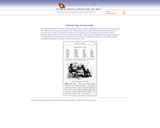
What many former slaves wanted most, both for themselves and their children, was education. With their own resources and help from northern missionary groups and the government, freedpeople built and maintained schools and hired black teachers all across the South, sometimes in places that symbolized the old oppression, such as the Savannah slave market. Northern reformers prepared textbooks for freedmen and women, which often contained more than practical lessons. Besides instructions on spelling, reading, and pronunciation, this page from The Freedman's Second Reader presented a model" black household that exhibited the gentility of the northern middle-class ideal of the family."

In the post-Reconstruction era, Southern states mobilized a vast campaign of suffrage restriction--fraud, registration laws, and literary tests--in an effort to disempower African Americans and maintain Democratic party dominance. Although these restrictions were most often directed at black voters, those that barred voting on the basis of literacy or ownership of property also affected poor whites. Many northerners supported suffrage restriction as well. Between 1889 and 1913, nine states outside the South added restrictions requiring voters to read English, and ostensible reforms like the secret ballot were often directed at pushing out foreign-born and illiterate voters. One form of voting restriction aimed specifically at African Americans was the Grandfather clause that allowed men to register to vote only if they could have voted in 1867 (before African Americans were allowed to vote in the South) or descended from an 1867 voter. This excerpt from the Louisiana law of 1898 was typical of many such restrictions. The cumulative effect of the different restriction efforts was to reduce overall voting levels by more than a third and black voting rates by almost two thirds.

The Birth of a Nation, which opened in March 1915, was simultaneously a landmark in the history of American cinema and a landmark in American racism. The film depicted the South, following the assassination of President Lincoln, as ruled by rapacious African Americans, who by the film's end were heroically overthrown from power by the Ku Klux Klan. The National Association for the Advancement of Colored People (NAACP) attempted to mount boycott of the film, but it failed to stir significant white opposition. Ten days after Birth opened in New York City, noted reformer and NAACP board member Jane Addams (founder of Hull House, the Chicago settlement house) was interviewed by the New York Post about the film. Though Addams abhorred the film's portrayal of African Americans, she nonetheless conceded--perhaps intimidated by director D.W. Griffith's unrelenting efforts to cloak the film in the mantle of historical "accuracy"--that "some of the elements of the plot are based on actual events." This statement suggested how deeply the pro-Southern interpretation of Reconstruction had permeated popular understanding of that history, and Griffith was able to cite contemporary academic historians to support this view.

In a message to Congress in February 1948, President Harry S. Truman asked for Federal civil rights legislation, including antilynching laws. The last such bill to be signed into law, the 1875 Civil Rights Act, had been declared unconstitutional by the Supreme Court in 1883, during a period in which the number of lynchings of African Americans in the South increased sharply. The history of failed attempts to pass Federal antilyching legislation goes back to 1894, when a House bill to create a committee to investigate lynchings failed. In 1922, the House passed a bill by a two-to-one margin to make lynching a Federal crime, but despite President Warren G. Harding's support, Southern senators filibustered and defeated it. In 1933, President Franklin D. Roosevelt failed to support an antilynching bill proposed by the NAACP, fearing that key Southern lawmakers would retaliate and interfere with his New Deal agenda. In the following testimony to a House subcommittee in 1949, representatives of a Japanese American antidiscrimination league and the NAACP argued the need for Federal civil rights action. None of the bills under consideration by the subcommittee passed. President Dwight D. Eisenhower signed into law the first civil rights legislation since Reconstruction in 1957, but only the 1964 Civil Rights Act began to implement Federal laws and enforcement powers.

The New Deal Public Works Administration, created in 1933, built public institutions, but failed to ease the severe housing shortage by constructing homes. In 1934, Congress created the Federal Housing Administration (FHA) to insure home mortgages and loans for home repairs at low-interest, long-term rates. While the FHA helped middle-income homeowners, it refused to insure mortgages in poorer inner-city areas where the risks of default were seen as greater than in the suburbs. FHA guidelines also by supporting racial covenants that prevented African Americans from moving into "white" neighborhoods. The following statement by a Newark, New Jersey, African-American newspaper to a joint Congressional committee on housing—created by anti-housing reform legislators to stall passage of a public housing bill—charged that policies of racial discrimination denied access to people of color for housing in both private and public facilities. The Supreme Court ruled in 1948 that restrictive covenants were not legally enforceable and FHA subsequently banned restrictive covenant clauses in contracts. Racial discrimination in housing continued, however, in sales of existing houses and through unwritten "gentlemen's agreements" between realtors and buyers. The Civil Rights Act of 1964 barred discrimination in public accommodations, but de facto segregation continued in many parts of the U.S.

After fighting World War I, ostensibly to defend democracy and the right of self-determination, thousands of African-American soldiers returned home to face intensified discrimination, segregation, and racial violence. Drawing on this frustration, Marcus Garvey attracted thousands of disillusioned black working-class and lower middle-class followers to his Universal Negro Improvement Association (UNIA). The UNIA, committed to notions of racial purity and separatism, insisted that salvation for African Americans meant building an autonomous, black-led nation in Africa. As Garvey's influence in the black community grew, so too did the voices of his many critics. Integrationists such as W. E. B. Du Bois and Robert Bagnall, both of the NAACP, worried that the UNIA leader was exploiting black disillusionment for personal gain. Moreover, they objected to the UNIA's call for racial separatism, and in this 1923 article Bagnall accused Garvey of "madness."

Spirituals and work songs, rooted in both the slavery era and the West African societies from which most African-American slaves were originally taken, provided cultural sustenance to African Americans in the midst of intense racial oppression. Folklorists first began collecting traditional southern music in the late-19th century. By the 1920s and 1930s, John and Alan Lomax were recording southern musicians (African-American, white, and Mexican-American) for the Library of Congress. "Run, Old Jeremiah," sung by Joe Washington Brown and Austin Coleman in Jennings, Louisiana, in 1934, was a ring-shout, a religious song using a West African dance pattern, where the performers shuffled single file, clapping out a complex counter-rhythm. The ring-shout was common during slavery and remained popular well into the 20th century as a means of emotional and physical release during religious worship. The lyrics of the ring-shout spoke of escape from the travails of the present.

Domestic service was the most common category of employment for women before World War II; it was particularly important for black women, who were excluded from most other occupations. By 1920 some 40 percent of all domestic workers were African American--and more than 70 percent of all wage-earning African-American women worked as servants or laundresses. The struggles of domestic workers were sometimes recorded in songs like Hattie Burleson's 1928 "Sadie's Servant Room Blues," a musical version of common complaints of domestic workers about long hours, low pay, and lack of privacy.

As U.S. soldiers returned from Europe in the aftermath of World War I, scarce housing and jobs heightened racial and class antagonisms across urban America. African-American soldiers, in particular, came home from the war expecting to enjoy the full rights of citizenship that they had fought to defend overseas. In the spring and summer of 1919, murderous race riots erupted in 22 American cities and towns. Chicago experienced the most severe of these riots. On Sunday, July 27, white bathers attacked several black youths swimming near one of Lake Michigan's white beaches, resulting in the death of an African-American boy. Five days of intense racial violence followed, claiming the lives of 23 black and 15 white Chicagoans, with more than 500 others wounded and thousands of black and white citizens burned out of their homes. A plethora of news reports and editorials offered instant analysis and helped shape local and national attitudes. On July 28, 1919, the Chicago Daily News printed this article by noted poet Carl Sandburg on its front page. Unlike most white reporters, Sandburg relied on black sources in researching his articles. The Chicago Daily News 's reporting on the riot was generally considered the most evenhanded of the city's daily newspapers, yet even it inflamed tensions by printing unsubstantiated stories. For example, the same front page included a "bulletin" that recounted supposed African-American plans to retaliate against white rioters.
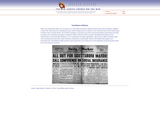
When nine young black males, one as young as 12, were falsely accused of raping two white women near Scottsboro, Alabama, in 1931, their case became an international cause celebre largely due to the activism of the Communist Party of the United States (CPUSA). Here, the Daily Worker, the CPUSA's newspaper, announces one of the many demonstrations sponsored by the Party in support of the Scottsboro defendants. Despite the efforts of first the CPUSA and later the National Association for the Advancement of Colored People (NAACP), a more mainstream civil rights organization, eight of the so called Scottsboro Boys" were convicted and sentenced to death following a trial based on questionable evidence and riddled with prejudice and procedural error. Eventually the death sentences were overturned

In 1887, Florida passed the first law requiring railways to provide "equal but separate accommodations for the white, and colored, races," and Mississippi, Texas, and other states soon followed suit. When Louisiana passed such a law in 1890, African Americans in New Orleans resisted in several ways, including mounting a legal challenge to it. In 1892 they arranged for Homer Adolph Plessy (who was one-eighth black and could have readily "passed" for white) to be arrested on an East Louisiana Railway train for refusing to move to the car designated for "colored passengers." The case eventually reached the U.S. Supreme Court in 1896 as Plessy v. Ferguson (named for the New Orleans Criminal District Court Judge who first ruled against Plessy). The Plessy decision, excerpted below, was written by Justice Henry Billings Brown. Brown argued that as long as racially separate facilities were equal they did not violate the Fourteenth Amendment's guarantees of equal protection of the law. All of the justices but one (John Marshall Hylan) agreed with Brown's arguments. The Plessy ruling provided legal justification for segregation in transportation, public accommodations, and schools until the Supreme Court effectively overruled it in the 1954 Brown v. Board of Education decision.

The Women's Trade Union League (WTUL), established in 1903 by reformers seeking to combine the forces of trade unionism and feminism, faced particular obstacles when organizing women into unions. In this 1915 essay, published in The Trade Union Woman, WTUL leader Alice Henry discussed some of those problems and advocated separate women's locals as a possible solution. Another important organizing problem, which Henry did not discuss, was the tension between the middle-class reformers of the WTUL and the working-class women they wanted to organize but sometimes viewed with condescension. Henry was an Australian journalist of pro-labor and anti-imperialist sympathies. In 1906, she immigrated to the U.S., joined the fight for suffrage, and became a leader of the WTUL. Although she started out sharing the racist views of many Australians (where a "White Australia" policy was widely accepted), her time in America led her to adopt more favorable views of African Americans and immigrants.

Between 1916 and 1921 a half million African Americans left the South and journeyed to cities in the North and West in what was then the largest internal movement of a people in such a concentrated period of time in the history of the nation. Migrants' letters to northern newspapers were among the best and most voluminous sources for understanding the migration process and interpreting the migrants' motivations for leaving. Seven letters to the Chicago Defender -- a black newspaper published in Chicago that strongly urged southern blacks to migrate North--attest to migrants' strong desire to "better their condition," often risking their lives and possessions to make the trip north.
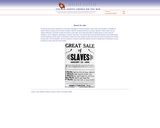
The twenty-three slaves advertised on this poster belonged to a Kentucky planter, John Carter, who decided to "liquidate his assets" before moving to the free state of Indiana. With the westward extension of slavery, planters in older states such as Virginia, Maryland, and North Carolina found they could make up for declining profits by selling slaves to newer areas of cultivation, such as Alabama, Mississippi, Louisiana, and Texas. The internal slave trade destroyed families and brought misery to both individuals and the larger communities in which they lived. Between a fifth and a third of all slave marriages were broken through sale or forced migration, and the expansion of slavery meant that relatives forced to relocate were more likely to end up hundreds of miles away from their families.

While the numbers of free blacks remained small in the South through the mid-nineteenth century, their presence aroused great anxiety among whites. Legislatures passed laws limiting African-American political and social rights. Non-slaveholding whites often viewed free black labor as competition, especially in urban areas where tensions between the two groups sometimes ran high. In 1838, J. J. Flournoy, a white Georgian artisan, wrote this letter to the Athens Southern Banner complaining about the competition posed by black workers. While he noted in passing that the white majority of the poor should band together to elect representatives to ensure laws that would privilege white labor over black, he more forcefully appealed to a common "whiteness" among contractors and carpenters, proprietors and workers.

The Jamaican-born Marcus Garvey, a brilliant orator and black nationalist leader, turned his Universal Negro Improvement Association (UNIA) into the most important black organization in the United States in the early 1920s. Garvey's speeches often drew huge audiences, and stories of Garvey's stubborn resistance in the face of white hostility proliferated among his supporters. In an oral history interview, devotee Audley Moore remembered the Jamaican's defiant behavior at a rally in New Orleans caused "the [white] police [to] file out . . . like little puppy dogs with their tails behind them." She proudly recalled the crowd intimidating the police by raising their guns and chanting "speak, Garvey, speak."